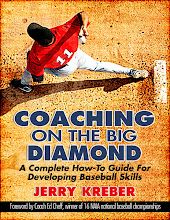Saturday, December 10, 2005
The Unknown Muscle

Why is Pronation Important?
To the right, I have posted a picture on the forearm. In this picture, highlighted in red, is the pronator teres muscle. This muscle controls the pronation of the pitcher’s hand just before the ball release. As you can see, the muscle starts under the elbow and wraps around to top of the forearm connecting to the wrist. If you want to find the muscle, place your left hand where your right elbow and forearm meet. Then, extend your right wrist up and down. You should feel a muscle contract under the forearm, enxt to the elbow. This muscle is the pronator teres. For anyone who does not think they pronate before release, here is some interesting proof. In the August 2005 edition of Strength and Conditioning Journal, Jeff Jeran and Robert Chetlin state that pronation of the forearm occur 10 milliseconds before release. These two men have written a highly informational article on pitcher’s arm strengthening and stabilizing. This is not the first time information on pronate has been published. Will Carroll, in his book Saving the Pitcher, documented that pitchers pronate their forearm just before release. He even offers a picture of Mark Prior pronating his hand while releasing the baseball during practice. Their theories of pronation would only strengthen Dr. Marshall’s idea of training pitchers to strongly pronate their throwing arm to increase pitching velocity. Below, I am listed some exercises that our pitchers will incorporating this season to improve pronator strength:
1. Wrist Contractions: The pitcher, with 2-3 lbs. dumbbells, will be in a seated position. The pitcher will rest his pitching forearm on his quadriceps. The players hand should be extended past the knee so his hand can move freely up and down. Only his forearm should be supported by the quadriceps. With his throwing arm’s forearm supported and wrist in a neutral position, the pitcher will lower the dumbbell to full wrist extension. At full extension, the pitcher should feel his forearm muscle contract. The pitcher will hold for two second, and then raise the wrist back to the neutral position. The pitcher will perform three sets of 20.
2. Thumb Turns: The pitcher, with 2-3 lbs. dumbbells, will be in a seated position. The pitcher will rest his pitching forearm on his quadriceps. The players hand should be extended past the knee so his hand can move freely up and down. Only his forearm should be supported by the quadriceps. With his throwing arm’s forearm supported and wrist in a neutral position, the pitcher will turn their thumb down like twisting a door knob open, finshing with his pinky finger facing up. The pitcher should feel his forearm muscle contract. The pitcher will hold for two second, and then turn the wrist back to the neutral or handshake position. The pitcher will perform three sets of 20.
3. Weighted Ball Pronations: The pitcher, with a 7-ounce ball, will be down on their throwing arm knee. The pitcher will place his throwing elbow in this glove to support the throwing arm’s weight and target the hand movement during release. The player’s wrist should start in a neutral position and bring the ball back to a cocked position. Then, the pitcher should “flick” the ball to his throwing partner. During this phase, the pitcher will pronate the hand during the “flick” so the pinky finger is pointing up after release. The pitcher will perform three sets of 20.
4. Tennis Ball Squeezes: Seated on a bench or chair, the pitcher will let their arms dangle at their sides. In each hand, the pitcher will have a standard tennis ball. For one minute intervals, the pitcher will squeeze the tennis balls as many times as time allows. The pitcher should keep arms at their sides to increase and stimulate blood supply to the muscle. Pitchers will do three sets at one minute each.
5. Shot Put Turns: The pitcher will standard in the standard shot put position. Their elbow should be up and parallel or above the shoulder. The shot put, weighing approximately 12 lbs, will rest to against the pitcher’s trapeziums muscle located close to the neck. The pitcher, not dropping the elbow, will raise the shot put by extending the arm. While extension occurs, the pitcher will rotate their thumb in a counter clockwise position. Once extension has occurred, the pitcher will rotate thumb back to neutral and lower the shot back to the original position. The pitcher should place special emphasis on never dropping the elbow lower than shoulder level. For pitchers who are inexperienced at using the shot put, coaches should hold their elbow during the exercises. Pitchers will do three sets of 10.
